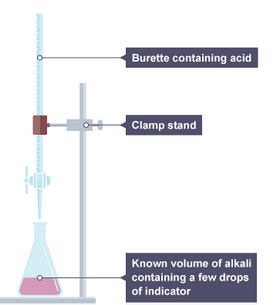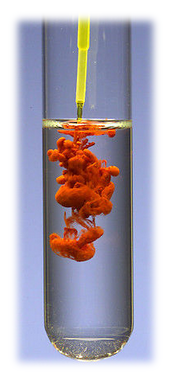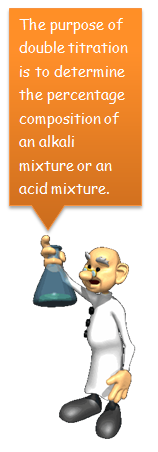Volumetric Analysis
Table of Content |
The volumetric analysis is an analytical method of estimating the concentration of a substance in a solution by adding exactly same number of equivalents of another substance present in a solution of known concentration.
The substance whose solution is employed to estimate the concentration of unknown solution is called titrant and the substance whose concentration is to be estimated is called titrate.
The volumetric analysis is divided into following types:
-
Simple titration
-
Back titration
-
Double titrations

Simple Titrations
The aim of simple titration is to find the concentration of an unknown solution with the help of the known concentration of another solution.
Let us take a solution of a substance ‘A’ of unknown concentration. We are provided with solution of another substance ‘B’ whose concentration is known (N1). We take a certain known volume (V2 litre) of ‘A’ in a flask and start adding ‘B’ from burette to ‘A’ slowly till all the ‘A’ is consumed by ‘B’. This can be known with the aid of suitable indicator, which shows colour change after the complete consumption of ‘A’. Let the volume of B consumed is V1 litre
According to the law of equivalents, the number of equivalents of ‘A’ would be equal to the number of equivalents of ‘B’.
Hence
N1V1 = N2V2,
where N2 is the concentration of ‘A’.
Thus using this equation, the value of N2 can be calculated.
There are four types of simple titration, namely
 Acid- Base Titrations
Acid- Base Titrations
In this type of titration, the concentration of an acid in a solution is estimated by adding a solution of standard base and vice versa.
The equivalence point is detected by adding a few drops of a suitable indicator to the solution whose concentration is to be estimated.
An acid-base indicators gives different colours with acids and bases. The choice of indicator in a particular titration depends on the pH-range of the indicator and the pH change near the equivalence point.
For example,
Strong Acid - Strong Base Titration
In the titration of HCI vs NaOH, the equivalence point lies in the pH range of 4-10. Thus, methyl red (pH-range 4.2 to 6.3), methyl orange (pH-range 3.1 to 4.4) and phenolphthalein (pH-range 8.3 – 10) are suitable indicators of such titrations.
Weak Acid - Strong Base Titration
In the titration of CH3COOH and NaOH, the equivalence point lies between 7.5 and 10. Thus, phenolphthalein is the suitable indicators.
Weak Base - Strong Acid Titration
In the titration of CH3COOH and NH4OH, the equivalence point lies between 4 to 6.5. Thus methyl orange and methyl red are suitable indicators.
Weak Acid - Weak Base Titration
In the titration of CH3COOH and NH4OH, the equivalence point lies between 6.5 and 7.5 and the pH change is not sharp at the equivalence point. Thus, no simple indicator can be employed to detect the equivalence point.
Redox Titrations
In a redox titration, an oxidant is estimated by adding reductant or vice-versa.
For example, Fe2+ ions can be estimated by titration against acidified KMnO4 solution when Fe2+ ions are oxidized to Fe3+ ions and KMnO4 is reduced to Mn2+ in the presence of acidic medium.
KMnO4 functions as self-indicator as its purple colour is discharged at the equivalence point.
Fe2+ → Fe3+ + e–] × 5
Mn![]() + 8H+ + 5Fe2+ → Mn2+ + 5Fe3+ + 4H2O
+ 8H+ + 5Fe2+ → Mn2+ + 5Fe3+ + 4H2O
(n=5) (n=1)
In addition to acidified KMnO4, acidified KCr2O7 can also be employed. Other redox titration are iodimetry, iodometry etc.
Iodimetry
This titration involves free iodine. Such direct estimation of iodine is called iodimetry.
This involves the titration of iodine solution with known sodium thiosulphate solution, whose normality is N. Let the volume of sodium thiosulphate used be V litre.
I2 + 2Na2S2O3 → 2NaI + Na2S4O6
(n=2) (n=1)
Equivalents of I2 = Equivalents of Na2S2O3 used = N × V
Moles of I2 = ![]()
Mass of free I2 in the solution = ![]() g
g
Iodometry
This is an indirect method of estimation of iodine. An oxidizing agent is made to react with excess of solid KI. The oxidizing agent oxidizes I– to I2.
This liberated I2 is then made to react with Na2S2O3 solution of normality N. Let the volume of thiosulphate solution required be V litre.
Oxidising Agent (A) + KI I2 ![]() 2NaI + Na2S4O6
2NaI + Na2S4O6
+
Reduced form of oxidizing agent
Equivalents of ‘A’ = Equivalents of I2 = Equivalents of Na2S2O3 used = N × V
Equivalents of I2 liberated from KI = N × V
Equivalents of ‘A’ = N × V
Let the n-factor of ‘A’ in its reaction with KI be x, then
Mass of ‘A’ consumed = ![]() × MA (where MA is the molar mass of A)
× MA (where MA is the molar mass of A)
Precipitation Titrations
In a titration of this kind, cations and anions combine to form a compound of very low solubility. Thus, a solid residue separates out.
For example,
AgNO3 + NaCI → AgCI¯ (white) + NaNO3
BaCI2 + H2SO4 → BaSO4¯ (white) + 2HCI
Complexometric Titrations
In this type of titration, the titrate combines with the titrant to form complex salts. The complex salts may or may not be soluble. For example,
CuSO4 + 4NH4OH → [Cu(NH3)4]SO4 + 4H2O
AgNO3 + 2KCN → K[Ag(CN)2] + KNO3
Refer to the following video for problem on acid-base titration
Back Titration
Let us assume that we have an impure solid substance ‘C’, weighing ‘w’ g and we are required to calculate the percentage purity of ‘C’ in the sample. We are also provided with two solutions ‘A’ and ‘B’, where the concentration of ‘B’ is known (N1) and that of ‘A’ is unknown.
For the back titration to work, following conditions are to be satisfied
-
Compounds ‘A’, ‘B’ and ‘C’ should be such that ‘A’ and ‘B’ react with each other.
-
‘A’ and pure ‘C’ also react with each other but the impurity present in ‘C’ does not react with ‘A’.
-
Also the product of ‘A’ and ‘C’ should not react with ‘B’.
Now we take out certain volume of ‘A’ in a flask (the equivalents of ‘A’ taken should be > equivalents of pure ‘C’ in the sample) and perform a simple titration using ‘B’. Let us assume that the volume of ‘B’ used be V1 litre.
Equivalents of ‘B’ reacted with ‘A’ = N1V1
Hence Equivalents of ‘A’ initially = N1V1
In another flask, we again take some volume of ‘A’ but now ‘C’ is added to this flask. Pure part of ‘C’ reacts with ‘A’ and excess of ‘A’ is back titrated with ‘B’. Let the volume of ‘B’ consumed is V2 litre.
Equivalent of ‘B’ reacted with excess of ‘A’ = N1V1
Hence Equivalents of ‘A’ initially = N1V1
Equivalents of pure ‘C’ = (N1V1 – N1V2)
Let the n-factor of ‘C’ in its reaction with ‘A’ be x, then the moles of pure ‘C’ = ![]()
Hence Mass of pure ‘C’ = ![]() × Molar mass of ‘C’.
× Molar mass of ‘C’.
Hence Percentage purity of ‘C’ = ![]() ×
× ![]() × 100
× 100
Double Titrations
The purpose of double titration is to determine the percentage composition of an alkali mixture or an acid mixture. In the present case, we will find the percentage composition of an alkali mixture. Let us consider a solid mixture of NaOH, Na2CO3 and some inert impurities, weighning ‘w’ g. We are required to find the % composition of this alkali mixture. We are also given an acid reagent (HCI) of known concentration M1 that can react with the alkali sample.
We first dissolve this mixture in water to make an alkaline solution and then we add two indicators, (Indicators are substances that indicate colour change of solution when a reaction gets completed), namely phenolphthalein and methyl orange to the solution. Now, we titrate this alkaline solution with standard HCI.
NaOH is a strong base while Na2CO3 is a weak base. So it is obvious that NaOH reacts first with HCI completely and Na2CO3 reacts only after complete NaOH is neutralized.
NaOH + HCI → NaCI + H2O …..(i)
Once NaOH has reacted completely, then Na2CO3 starts reacting with HCI in two steps, shown as
Na2CO3 + HCI → NaHCO3 + NaCI ……. (ii)
NaHCO3 + HCI → NaCI + CO2 + H2O …… (iii)
It is clear that when we add HCI to the alkaline solution, alkali is neutralized and the pH of the solution decreases. Initially the pH decrease would be rapid as strong base (NaOH) is neutralized completely.
When Na2CO3 is converted to NaHCO3 completely, the solution is still weakly basic due to the presence of NaHCO3 (which is weaker as compared to Na2CO3). At this point, phenolphthalein changes colour since it requires this weakly basic solution to show its colour change.
When HCI is further added, the pH again decreases and when all the NaHCO3 reacts to form NaCI, CO2 and H2O the solution becomes weakly acidic due to the presence of the weak acid (H2CO3). At this point, methyl orange changes colour as it requires this weakly acidic solution to show its colour change.
Thus in general, phenolphthalein shows colour change when the solution contains weakly basic NaHCO3 along with other neutral substances while methyl orange shows colour change when solution contains weakly acidic H2CO3 along with other neutral substances.
Let the volume of HCI used up for the first and the second reaction be V1 litre (this is the volume of HCI used from the beginning of the titration up to the point when phenolphthalein shows colour change) and the volume of HCI require for the third reaction be V2 litre (this is the volume of HCI used from the point where phenolphthalein had changed colour upto the point when methyl orange shows colour change). Then,
Moles of HCI consumed by NaHCO3 = Moles of NaHCO3 reacted = M1V2
Moles of NaHCO3 formed from Na2CO3 = M1V2
Moles of Na2CO3 in the mixture = M1V2
Mass of Na2CO3 in the mixture = M1V2 × 106
% of Na2CO3 in the mixture = ![]()
Moles of HCI used in te reaction (i) and (ii) = M1V1
Moles of HCI used in reaction (ii) = M1V2
Moles of HCI used in reaction (i) = (M1V1 – M1V2)
Hence Moles of NaOH = (M1V1 – M1V2)
Mass of NaOH = (M1V1 – M1V2) × 40
% of NaOH in the mixture = ![]()
Here, we have determined the percentage composition of the mixture using mole concept, as the balanced reactions were available. If we were to solve this by equivalent concept, then the procedure adopted would be
NaOH + HCI → NaCI + H2O …….(i)
Na2CO3 + HCI → NaHCO3 + NaCI …….(ii)
(n=1) (n=1) (n=1)
Phenolphthalein shows end point after reaction (ii)
NaHCO3 + HCI → NaCI + CO2 + H2O ……...(iii)
(n=1) (n=1)
and methyl orange shows end point after reaction (iii).
At phenolphthalein end point,
(Equivalents of HCI)1 = Equivalents of NaOH + Equivalents of Na2CO3 (n=1) = M1V1
or (Equivalents of HCI)1 = Equivalents of NaOH +½ Equivalents of Na2CO3 (n=2) ..(iv)
At methyl orange end point,
(Equivalents of HCI)2 = Equivalents of NaHCO3 reacted (n=1) = Equivalents of NaHCO3 produced (n=1) = Equivalents of Na2CO3 (n=1)
Hence M1V2 = Equivalents of Na2CO3 (n=1) = ½ Equivalent of Na2CO3 (n=2) ……..(v)
Subtracting equation (v) from equation (iv),
Equivalents of NaOH = (M1V1 – M1V2)
Hence Moles of NaOH = (M1V2 – M1V2) (since n-factor of NaOH is 1)
Hence % of NaOH in the mixture = ![]()
Equivalents of Na2CO3 (n=1) = M1V2
and moles of Na2CO3 = M1V2 (since n-factor of Na2CO3 is 1)
Hence % of Na2CO3 in the mixture = ![]()
In the above case, we have taken alkali mixture of NaOH & Na2CO3. But other alkali mixtures can also be taken.
|
(i) If a mixture of NaOH and NaHCO3 has been taken
(ii) If a mixture of Na2CO3 and NaHCO3 has been taken
(iii) If a mixture of NaOH, Na2CO3 and NaHCO3 has been taken
|
Solved Example |
|
Question: A solution contains a mixture of Na2CO3 and NaOH. Using phenolphthalein as indicator, 25 ml of mixture required 21 ml of 1.1 N HCI for the end point. With methyl orange as indicator, 25 ml of solution required 25 ml of the same HCI for the end point. Calculate grams per litre of each substance in the mixture. Solution: Since, the volume of HCI required in titration using methyl orange is greater than the volume of HCI required using phenolphthalein, this means that the titration is carried out separately two times using phenolphthalein and methyl orange indicators, respectively. NaOH + HCI → NaCI + H2O …… (i) Na2CO3 + HCI → NaHCO3 + NaCI ……. (ii) NaHCO3 + HCI → NaCI + CO2 + H2O …….. (iii) Thus, the volume of HCI used in third reaction = (25 – 21) = 4.0 ml Hence Moles of HCI used in third reaction = 4.0 × 10–3 × 1.1 Moles of NaHCO3 reacted = 4.4 × 10–3 Moles of NaHCO3 produced = 4.4 × 10–3 Hence Moles of Na2CO3 present in 25 ml = 4.4 × 10–3 Hence Mass of Na2CO3 present in 1 litre = 4.4 × 10–3 × 106 × 40 = 18.656 g Moles of HCI reacted in second reaction = 4.4 × 10–3 Moles of HCI used in first two reactions = 21 × 10–3 × 1.1 = 23.1 × 10–3 Hence Moles of HCI used in first reaction = (23.1 – 4.4) × 10–3 = 18.7 × 10–3 Moles of NaOH present in 25 ml = 18.7 × 10–3 Hence Mass of NaOH present in 1 litre = 18.7 × 10–3 × 40 × 40 = 29.92 g |

Question 1: Which of the following types of titration is not a simple titration?
a. Acid-base titrations
b. Back titration
c. Precipitation titrations
d. Complexometric titrations
Question 2: According to the law of equivalents,
a.N2V1 = N1V2,
b.N1V2 = N2V1,
c.N1V1 = N
d. V = N2V2,
Question 3: Which of the following conditions is nor required for the back titration to work ?
a. Compounds ‘A’, ‘B’ and ‘C’ should be such that ‘A’ and ‘B’ react with each other.
b. ‘A’ and pure ‘C’ also react with each other but the impurity present in ‘C’ does not react with ‘A’.
c. Product of ‘A’ and ‘C’ should not react with ‘B’.
d. Product of ‘A’ and ‘B’ should be ‘C’.
Question 4: The titration in which an oxidizing agent is made to react with excess of solid KI and the oxidizing agent oxidizes I– to I2 is known as
N2(g) + 3H2(g) → 2NH3(g) ?
a. Iodometry
b. Iodimetry
c. Double titration

|
Q.1 |
Q.2 |
Q.3 |
Q.4 |
|
b |
a |
d |
a |
Related Resources
-
Look here for past year papers of IIT JEE
-
Click here to refer syllabus of chemistry for IIT JEE
View courses by askIITians


Design classes One-on-One in your own way with Top IITians/Medical Professionals
Click Here Know More

Complete Self Study Package designed by Industry Leading Experts
Click Here Know More

Live 1-1 coding classes to unleash the Creator in your Child
Click Here Know More



